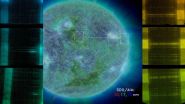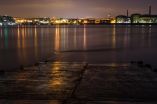(Press-News.org) The sun's surface is blisteringly hot at 10,340 degrees Fahrenheit -- but its atmosphere is another 300 times hotter. This has led to an enduring mystery for those who study the sun: What heats the atmosphere to such extreme temperatures? Normally when you move away from a hot source the environment gets cooler, but some mechanism is clearly at work in the solar atmosphere, the corona, to bring the temperatures up so high.
Clear evidence now suggests that the heating mechanism depends on regular, but intermittent explosive bursts of heat, rather than on continuous gradual heating. This solution to the coronal heating mystery was presented in a media briefing on April 28, 2015, at the Triennial Earth-Sun Summit, or TESS, meeting in Indianapolis, Indiana.
This is the inaugural meeting for TESS, which is a first of its kind: uniting the various research groups that study the sun-Earth connection from explosions on the sun to their effects near our home planet and all the way out to the edges of the solar system - a research field collectively known as heliophysics. The overarching goal is to share techniques across disciplines and encourage interdisciplinary collaboration on outstanding heliophysics questions.
The coronal heating mystery is one such outstanding question. Four scientists spoke at the media briefing.
Jim Klimchuk, a solar scientist at NASA's Goddard Space Flight Center in Greenbelt, Maryland, explained that the new evidence supports a theory that the sun's corona is heated by tiny explosions called nanoflares. These are impulsive heating bursts that individually reach incredibly hot temperatures of some 10 million Kelvins or 18 million degrees Fahrenheit - even greater than the average temperature of the corona - and provide heat to the atmosphere. The research evidence presented by the panel spotted this super hot solar material, called plasma, representative of a nanoflare.
"The explosions are called nanoflares because they have one-billionth the energy of a regular flare," said Klimchuk. "Despite being tiny by solar standards, each packs the wallop of a 10 megaton hydrogen bomb. Millions of them are going off every second across the sun, and collectively they heat the corona."
The first evidence of the presence of this super hot plasma was presented by Adrian Daw, a solar scientist at Goddard and principal investigator of the Extreme Ultraviolet Normal Incidence Spectrograph, or EUNIS, sounding rocket mission. EUNIS flew on a 15-minute flight in December 2013 equipped with an instrument called a spectrograph, which can gather information about how much material is present at a given temperature. The EUNIS spectrograph was tuned into a range of wavelengths useful for spotting material at temperatures of 18 million F, the temperatures that signify nanoflares. The spectrograph unambiguously spotted this extremely hot material in active regions that visibly appeared to be quiet. In a quiet region, such hot temperatures clearly weren't due to a large explosive solar flare, and so are a smoking gun that something otherwise unobservable was heating up this area.
Daw also reported the results from another experiment launched on sounding rockets in 2012 and 2013 that imaged soft X-rays from the corona. These results, too, confirmed the presence of super hot plasma on the sun.
Iain Hannah, an astrophysicist at the University of Glasgow in Scotland, spoke about NASA's Nuclear Spectroscopic Telescope Array, or NuSTAR, which typically examines X-rays from distant stars and black holes. However, it is also capable of observing the much brighter light of the sun - something most astronomical observatories can't do.
"X-rays are a direct probe into the high-energy processes of the sun," said Hannah.
NuSTAR saw X-rays that are signatures of super hot plasma in non-flaring active regions. While the sounding rocket experiments observed the energy produced by these nanoflares, NuSTAR is also able to look for the X-ray signatures of energetic particles. Understanding what and how particles are accelerated out from these smaller nanoflare explosions can help scientists understand what processes create them.
Stephen Bradshaw, a solar astrophysicist at Rice University in Houston, Texas, was the last speaker. Bradshaw used a sophisticated computational model to demonstrate why spotting signatures of the nanoflares has been so difficult and how the new evidence will help researchers go forward to improve theories on the details of coronal heating -- one day allowing heliophysics researchers to at last solve the coronal heating mystery.
The TESS meeting will occur every three years and is a joint meeting of the Space Physics and Aeronomy Section of the American Geophysical Union and the Solar Physics Division of the American Astronomical Society.
INFORMATION:
MISSOULA - Improved drilling technologies and energy demand have resulted in the large-scale expansion of oil and gas development, with 50,000 new wells drilled per year recently in central North America. Locations such as the Bakken, Eagle Ford and the Marcellus Shale are now commonplace, and drilling activity frequently makes news.
But what are the ecological consequences of this accelerated drilling activity? Researchers at the University of Montana have conducted the first-ever broad-scale scientific assessment of how oil and gas development transforms landscapes ...
Casting a large interdisciplinary research net has helped Simon Fraser University archaeologist Dana Lepofsky and 10 collaborators dig deeper into their findings about ancient clam gardens in the Pacific Northwest to formulate new perspectives.
Lepofsky's research team has discovered that Northwest Coast Indigenous people didn't make their living just by gathering the natural ocean's bounty. Rather, from Alaska to Washington, they were farmers who cultivated productive clam gardens to ensure abundant and sustainable clam harvests.
In its new paper published by American ...
Being bigger and bolder holds various benefits for male soldier beetles. They enjoy higher rates of successful courtship and more often land a larger, more fertile mate. These are some of the findings of a study led by Denson McLain of the Georgia Southern University in the US, published in Springer's journal Behavioral Ecology and Sociobiology.
The goldenrod soldier beetle or Pennsylvanian leatherwing (Chauliognathus pennsylvanicus) is native to Northern America. During its peak reproductive season, between September to early October, it only mates once a day. This normally ...
CHICAGO -- Genetic testing of Iñupiat people currently living in Alaska's North Slope is helping Northwestern University scientists fill in the blanks on questions about the migration patterns and ancestral pool of the people who populated the North American Arctic over the last 5,000 years.
"This is the first evidence that genetically ties all of the Iñupiat and Inuit populations from Alaska, Canada and Greenland back to the Alaskan North Slope," said Northwestern's M. Geoffrey Hayes, senior author of the new study to be published April 29, 2015, in the American ...
PULLMAN, Wash.--Climate change may be responsible for the abrupt collapse of civilization on the fringes of the Tibetan Plateau around 2000 B.C.
WSU archaeologist Jade D'Alpoim Guedes and an international team of researchers found that cooling global temperatures at the end of the Holocene Climatic Optimum, a 4,000 year period of warm weather, would have made it impossible for ancient people on the Tibetan Plateau to cultivate millet, their primary food source.
Guedes' team's research recently was published online in the Proceedings of the National Academy of Sciences. ...
A vaccine containing a protein necessary for virus replication can boost an HIV-infected patient's immune system, according to clinical research published in the open access journal Retrovirology. This boost can result in increased effectiveness of antiretroviral drugs.
When people are first diagnosed with HIV they are put on antiretroviral drugs, also known as highly active antiretroviral therapy (HAART). These drugs can stop the virus reproducing almost completely. When taking HAART, however, it is known that the virus can still replicate at low levels and accumulate ...
For patients in the early stage of non-small cell lung cancer, surgical resection yields optimal outcomes. Prior investigations have shown that different resection procedures have very different outcomes, with pneumonectomy associated with three-fold higher mortality than other resection types. While it is understandable that pathological and physiological factors influence a surgeon's choice of surgery for a particular patient, the results presented in this study suggest that physician discomfort with the operative complexities of a procedure may lead to selection of a ...
Hospital readmission rates after major thoracic surgery can run as high as 10-17%. Alarmingly, readmission after pulmonary resection for lung cancer has been associated with worse outcomes, including higher mortality. Thus, reducing readmissions after thoracic surgery can both save lives and reduce healthcare costs. Studies in internal medicine and cardiology have shown that programs that improve the transition from hospital to post-discharge care can be effective in decreasing emergency room visits and re-hospitalization. This study from McMaster University describes for ...
People suffering from the common lung disease, chronic obstructive pulmonary disease (COPD), have an increased risk of sudden cardiac death (SCD), according to new research published online today (Wednesday) in the European Heart Journal [1].
When compared with people of the same age and sex who do not have the disease, those with COPD have a 34% increased risk of SCD overall, but their risk almost doubles more than five years after first being diagnosed with COPD. In COPD patients who have frequent exacerbations (sudden worsening of their symptoms, such as shortness ...
Marine ecosystems can be changed by night-time artificial lighting according to new research published in the Royal Society journal Biology Letters. The results indicate that light pollution from coastal communities, shipping and offshore infrastructure could be changing the composition of marine invertebrate communities.
Researchers from the Universities of Exeter and Bangor used a raft in the Menai Strait to monitor how artificial light at night affects the settlement of marine invertebrates into new habitats. Light is an important cue which guides the larvae of marine ...



